Ballpark Design Legend Janet Marie Smith Brings Her Talents to Worcester for Polar Park
- Ken Smoller
- Jul 30, 2021
- 20 min read
Updated: 3 days ago

When a baseball fan thinks about the most influential people in the game over the last 40 years (some for better, some for worse), one would naturally think of star players like Barry Bonds, Hideo Nomo, David Ortiz and Cal Ripken, Jr. or the off-field impacts of Bud Selig, Joe Torre, Bill James, Theo Epstein or Billy Bean. Most causal followers of the “National Pastime” are unaware, however, of the urban design and architectural wizardry of Janet Marie Smith and how she has forever changed the game of baseball through her ballpark projects.

Polar Park in Worcester, MA opened to the public on May 11, 2021 before a Covid-limited “capacity” crowd of 2,377 fans with an 8-5 WooSox win over the Syracuse Mets.
Along with another baseball executive legend, Larry Lucchino (currently the President/CEO Emeritus of the Red Sox and Chairman/Principal Owner of the Red Sox Triple A affiliate Worcester Red Sox (aka the WooSox)), Ms. Smith revolutionized the game with both her ground-up plan for Camden Yards in Baltimore and her decade-long modernization of Fenway Park in Boston. Not only did she lead the retro design charge back to the urban core with Camden Yards, but changed the overall way that people look at ballparks forever.
Left: Everyone was filled with smiles during the ribbon cutting of Polar Park on Opening Day on May 11, 2021.
Right: Hall of Famer and Red Sox World Series hero Pedro Martinez greets Janet Marie Smith and Larry Lucchino before Pedro tosses out the First Pitch along with other dignitaries.
In this first of a three part series, I will explore the fantastic new Polar Park design for the WooSox and its role in revitalizing Worcester’s Canal District.
In the second part, I will delve deeper into how Janet Marie Smith’s and Larry Lucchino’s three decade collaboration changed ballpark design throughout the major and minor leagues.
Finally, the third part will focus on Ms. Smith’s $100 million dollar upgrades to the third oldest ballpark in the Majors – Dodger Stadium in Los Angeles.
These photo essays are based in large part on conversations that I had with both Ms. Smith and Mr. Lucchino, among others from the WooSox, who were all extremely generous with their time. I want to give a special shout-out to Ben Weingarten, Ballpark Design Coordinator for the WooSox, who was patient with my many questions and who might find himself being the next generation’s “Janet Marie Smith”. Additionally, the WooSox team President, Dr. Charles Steinberg (also known as “Dr. Charles”), who has worked with Lucchino and Smith at Baltimore, Boston, San Diego and Los Angeles, who provided me with a slew of anecdotes and facts about the design team and the park itself.
Each ballpark is snowflakesque unique. Given that a ballfield does not follow a specific standard or shape like basketball or American football, a ballpark may be tailored to a particular site, culture, climate, budget, playing style, topography or historical context. Based on my photographic visits to over 500 ballparks, the impact of architect and urban designer Janet Marie Smith (currently, Executive Vice President Planning and Development for the Los Angeles Dodgers) on all new parks since 1992 is clearly evident and cannot be overstated.
Quite simply, she has been an unparalleled legend in the ballpark design world since the early 90’s. Not only has Ms. Smith been involved with some of the most iconic ballpark projects in the last 30 years (Camden Yards, Petco Park, Fenway Park to name a few), but her urban planning background and emphasis has influenced stadium and ballpark development worldwide by stressing the integration of a sports venue within the fabric its urban environment.
Prior to the 1992 unveiling of Oriole Park in Camden Yards in Baltimore, many new stadiums and ballparks were plopped down in isolated lots on the outskirts of cities or suburbs. With Ms. Smith’s influence, almost every stadium since has sought a nexus with its surrounding area, with increasing accessibility to the public beyond just gameday. All of her experience and talents infused the Polar Park (named for Worcester-based company Polar Beverages) design and overall redevelopment of the surrounding Worcester neighborhood.
Left: One can see how Janet Marie Smith’s design for Fenway Park’s Green Monster seats influenced the design of the right field “Worcester Wall” seats at Polar Park.
Right: No detail is too small for Ms. Smith and her design team.
Polar Park in Worcester HAD to be a great ballpark. As is often repeated, New Englanders are a fickle bunch, who cling tightly to tradition. Given the regional nature of the Red Sox fandom, the Red Sox minor league teams have had a heavy footprint in New England – the Triple A Pawtucket Red Sox right next to Providence, RI, the Double A Seadogs in Portland, ME and, until recently, the Single A Spinners in Lowell, MA. Besides Fenway Park, one of the most cherished New England sports venues had been McCoy Stadium in Pawtucket, the long-time home of the Pawtucket Red Sox (aka the PawSox).
Left: Edward A. LeLacheur Park, home of the defunct single A Lowell Spinners.
Right: Hadlock Field, home of the double A Portland Seadogs and a replica of Fenway Park’s Green Monster
McCoy was a no frills, yet classic, old park that opened in 1942 and a final capacity of 10,031. Unlike most minor league facilities, it possessed a steeply pitched main grandstand that was somewhat elevated from the field, leading to fantastic sightlines. Among other quirks, the dugout at McCoy was not really “dug out”, but was at grade level and embedded into the grandstand wall. This unusual dugout feature gave fans a unique vantage point and led to an unusual method for requesting autographs. Instead of waiting for players to line up along the grandstand walls during batting practice, young fans would lower balls and autograph books into the dugout via makeshift fishing lines and other creative techniques.

Although antiquated by modern ballpark standards, McCoy Stadium in Pawtucket Rhode Island was beloved by generations of PawSox fans.
Left: McCoy’s elevated grandstand gave fans a top down perspective on the players.
Center: Fans got creative in search of autographs at McCoy Stadium in Pawtucket, especially with a shot at getting the signature of rehabbing Red Sox stars like Manny Ramirez (far right in dugout photo)
McCoy Stadium even had big-time history – hosting the longest ever professional baseball game of 33 innings on April 18-19, 1981. Despite the historic charm and years of negotiations, neither the cities of Pawtucket (best known as toy company Hasbro’s HQ) or nearby Providence could strike a deal for a modern ballpark to entice the team to stay in Rhode Island. Worcester, New England’s second largest city, however, took that stalemate as an opportunity and lured the team 42 miles northwest (remaining approximately an hour’s drive from Boston’s population base).
Even Janet Marie Smith was a fan of McCoy Stadium. When asked if she felt any pressure given the reverence for McCoy, she responded, “Sure, I love McCoy. I made no bones about that. I think it’s a really charming place, full of wonderful history. There are some architectural features about it that I really love – the steel trusses and the wood ceiling with the grooves. They are building materials that you will never see again. The fact that the roof covered all the fixed seating was kind of an interesting thing.
While I know it’s popular to poo poo all that foul territory, it’s kind of charming to have one or two places left that still have that pitcher friendly feature now that they’re the anomaly and not the norm. I certainly appreciate all the reasons that the team chose to move to Worcester, and what a wonderful opportunity it is for the city of Worcester…being part of an urban revitalization project like this and building on what they’ve done with the Canal District is very fulfilling.” Given all the history and warm feelings towards McCoy, Polar Park needed to be special to win over skeptical Red Sox nation.
Left: McCoy Stadium in Pawtucket, RI on July 9, 2021, still awaiting a new user.
Right: McCoy stadium served as a minor league ballpark since 1946.
Left: The longest game in professional baseball occurred on April 18-19, 1981 at McCoy
Stadium, in which the PawSox defeated the Rochester Redwings in a 33 inning game.
Right: Pawtucket, Rhode Island’s other claim to fame is being the hometown of toymaker, Hasbro.
If a park needs to be a great one, who better to helm the development than the ballpark design royalty duo of Janet Marie Smith and Larry Lucchino? Having already partnered on the highwire project of saving and renovating treasured Fenway Park, Ms. Smith and Mr. Lucchino were the perfect pair to develop not only a state of the art park, but help spur the overall redevelopment of neighboring land across Madison Street (the “SOMA” neighborhood as the WooSox planning team has dubbed the area).
As Dr. Charles explained to me, “ballparks are catalysts for changing downtowns. Janet Marie Smith and Larry Lucchino have used baseball to enhance the quality of life downtown.” To that end, Ben Weingarten explained that Dr. Charles met extensively with fans to seek their input on such topics, whose ideas were cataloged in a “Fan Plan Book”. With that philosophy in mind, the design team wanted to bring similar magic to the Canal District of Woo-town, just as they did in Charm City with Camden Yards. Ms. Smith said, “We are certainly hoping that all of those thousands of fans who will are showing up for games…will help populate the restaurants and the bars and people will find urban living a joy.”
With the announcement of the team’s move being made on August 18, 2018, anticipation was high for the WooSox’ new ballpark. The “Entering Worcester” sign has been installed in the picnic area in right field at Polar Park.
Naturally, designing a minor league ballpark differs in many ways from major league parks like Fenway and Camden Yards. Ms. Smith got experience in the smaller scale of minor league ballparks in her $31 million 2010 redevelopment of the Baltimore Orioles spring training home Ed Smith Stadium in Sarasota, FL. Beyond being smaller, the needs of fans differ. As Janet Marie explained to me spring training and minor league both share in common that “you want to win, but it’s not quite the same urgency…so you want to make certain it’s a good experience and that people feel like the food is fun and well presented, there are lots of things to look at, places to sit, room for kids to run around and find joy in what they’re doing.”
With the Ed Smith Stadium redevelopment, Smith and her team transformed an aging relic that Smith dubbed “such a little ugly duckling” into an inviting masterpiece by, among other things, adding a brand new thirty foot arcade that protected fans from the elements and allowed for a two level concourse. The scope of this project helped prepare Ms. Smith for her first ground-up minor league ballpark.
Before and after photos of Ed Smith Stadium in Sarasota, FL, the Baltimore Orioles spring training home.
Little do most baseball fans know, but Worcester has had a rich baseball past. The “Woo” even had a major league baseball team over three decades before the first brick was laid at Fenway Park . From 1880 to 1882, the redundantly named Worcester Worcesters played at the Worcester Agricultural Fairgrounds as a member of the National League.
Before their demise, the first ever major league perfect game was thrown by Worcester Worcesters pitcher Lee Richmond in 1880. More recently, the Worcester Tornados played the independent Can-Am League from 2005-2012 at a basic 3,000 seat ballpark named Hanover Insurance Park, situated right next to Holy Cross University’s football stadium Fitton Field. Since the Tornadoes folded in 2012, the people of “Woo-town” yearned for bigtime baseball.
Left: The Worcester Tornadoes play during the inaugural season in 2005 at Hanover Insurance Park.
Right: Holy Cross’s Fitton Field, with the Tornadoes’ ballpark visible beyond the endzone.
Although the team is the farm club of the Boston Red Sox, Mr. Lucchino and Ms. Smith did not want to build a mini-Fenway. Instead, Mr. Lucchino said the goal was to create a distinct ballpark that reflected Worcester’s “industrial nature”. With the potentially thankless mission ahead of them, Janet Marie Smith and Larry Lucchino got to work with their team.
Left: Fiddler’s Green Pub on nearby Temple Street.
Right: Union Station in Washington Square.
Team Chairman and Principal Owner Larry Lucchino wanted Polar Park to reflect that architecture of Worcester.
As a threshold matter, Larry Lucchino wanted to keep the business seats in the infield, with the party areas in the outfield (a baseball park version of the mullet). Charles Steinberg explained “Larry wanted traditional baseball lower seats between the bases and social gathering spaces where you could meet” in the outfield. This theme is consistent amongst all of the ballparks that bear the fingerprints of Janet Marie Smith and Larry Lucchino. True to form, there are party areas throughout the park and they are some of the best features.
While touring Polar Park, Janet Marie Smith proudly pointed to the Craft Corner in rightfield, an area overlooking the action where fans can mingle while sipping on a locally brewed IPA. The space has the feeling of a traditional New England clam shack, where people down canned beers and seafood while standing on crushed rock. Ms. Smith said the area is multi-decked as a nod to the traditional New England triple decker style housing. The social gathering areas continue on top of the 22 foot high right field “Worcester Wall”, with a variety of places to eat and drink, all with the field in sight. Beyond the left field fences, there are two levels of private party areas with picnic tables. With so many baseball-saturated beer gardens, Polar Park may prove an ideal launching spot for the college kids of Worcester to start their evening before heading out for a late night in nearby pubs, bars and restaurants.
Polar Park is brimming with social gathering areas that had the feeling of a beer garden or a traditional New England clam shack.
Beyond party areas that cater to college students from nearby Holy Cross, Clark University and Worcester Polytech, Janet Marie Smith ensured that young kids would not be left out of the fun. There is a huge grass berm in leftfield, an idea borrowed from McCoy Stadium, affording kids plenty of space to burn off Table Talk Pie energy. Nearby, there are tables and chairs that allow parents and caregivers to keep an eye on the kids and the game action simultaneously.
Ms. Smith said she doesn’t want to “penalize parents for bringing kids, so families can stay in touch [in this area].” The crowning jewel of the play area is a huge baseball themed playground in deep centerfield. Janet Marie, the mother of three grown children, beamed with pride during the Saturday in the Park open house as she watched kids play on the newly-installed equipment for the first time. While discussing the playground, her long-time colleagues, Larry Lucchino and Dr. Charles Steinberg, gently teased Ms. Smith that the “mom in her” put the kibosh on a contemplated splashpad.
In developing the ballpark, Larry Lucchino preached that the “overwhelming goal” was for Polar Park to “look, feel, taste and smell” like Worcester. While discussing this mantra about catering to this “foodie town”, Mr. Lucchino proudly pointed to an unassuming industrial building visible through the first base grandstand window. He explained that one of those smells emanates from the neighboring Table Talk Pies facility, whose pies are sold throughout New England and Polar Park. Another aroma comes from the Polar Park rightfield outpost of nearby legendary hot dog restaurant George’s Coney Island, founded in 1918.
To continue the Worcester food tour, Polar Park also features food from local restaurants as Wonder Bar Pizza and B.T.’s Smokehouse, with more to come soon. Given that the park’s naming partner is Polar Beverages, all of the park’s food stands feature Polar products.
The most exciting food development is coming soon to the Summit Street gate in deep centerfield. The goal for the Summit Street entryway is to approximate the vibe and energy of Fenway Park’s Jersey Street (formerly Yawkey Way) or Eutaw Street at Camden Yards.
Left: Eutaw Street at Camden Yards.
Right: Jersey Street (formerly Yawkey Way) at Fenway Park.
Summit Street’s food offerings will include an outpost of nearby Wormtown Brewery and a “Taste of Worcester” restaurant to be located in a repurposed shipping container. The Taste of Worcester will include a rotation of local chefs, with the goal being to reach out to small and minority owned businesses.
Drawings for the future Summit Street entrance in deep centerfield. Plans courtesy of the WooSox.
Summit Street also will include another of Worcester’s claims to fame – the “birthplace” of the diner restaurant. To highlight this history, the old Sherwood Diner is being restored and will be relocated to Summit Street. The diner, to be renamed “Diner 755” in honor of Hank Aaron’s career home run total, will house both the team’s flagship radio station and the philanthropic arm of the team – the WooSox Foundation. Rounding out the festive feeling, the area also will house one of Boston’s famous duck boats “Beantown Betty”. Betty is just one of the parade chariots used for the conquering heroes during Boston’s embarrassment of championship riches in the 21st century.
Two Worcester diners located near Polar Park.
Left: WooSox Chairman celebratng during the 2007 World Series championship parade. Center: 2007’s parade rolls down Boylston Street in Boston.
Right: The Duck boat “Beantown Betty” during the 2013 parade in the Charles River, which will soon be relocated to Polar Park to celebrate the WooSox’ parent club’s four World Series titles since 2004.
Polar Park’s front door on Madison Street features a unique facade. Unlike the main brick and faux brick facades that became common at ballparks following the groundbreaking retro design of Camden Yards, the Worcester ballpark reflects the city itself. If perfectly fits in with its industrial neighbors, but most significantly, is a nod to Worcester history. Architect Tommy Quirk of DAIQ Architects, Inc., who grew up in Worcester, based the design of the facade on the John W. Higgins Armory building four miles across town. Per the Armory’s website, the “building was constructed between 1929 and 1921 specifically to hold Higgin’s collection of arms and armor in a museum setting.”
For many years, it was the only museum in America that was purely focused on ancient and medieval arms and armor and featured the second largest collection in the U.S. after Metropolitan Museum of Art in NYC. Due to a lack of funding, the museum closed in 2013 and the collection has moved to the Worcester Museum of Art. Unlike the gray facade at Higgins, the ballpark’s “front door” is covered with what the design team calls “leisure blue”, with the Polar Park’s “salty dog” navy blue being painted on the letters along the top of the entryway.

Polar Park’s facade along Madison Street is an homage to Higgins Armory, formerly housing the John Woodman Higgins Armory Collection from 1931 until 2013.
The design team chose Gilbane Building Co. of Providence and AECOM Hunt of Los Angeles to handle construction for the project. Despite the stadium design dream team, the construction for the publicly funded Polar Park faced challenges on multiple fronts, bloating the budget as a result. According to the Worcester Business Journal, the final price tag made Polar Park the most expensive minor league park ever built, with it ultimately costing over $160 million.
As Ms. Smith detailed to me, the pandemic delayed the construction due to the Commonwealth-mandated 90 day work stoppage in the spring of 2020. During the stoppage, the team kept working behind the scenes in an effort to keep somewhat on track. Additionally, as a result of the pandemic, the construction team had to deal with various shortages in building supplies and unpredictable lead times. To add to the confusion, the nobody knew exactly when the project needed to be completed as the scheduling of Opening Day was uncertain.
Besides the pandemic, the topography of the site itself was complicated. The ballpark’s design needed to be adjusted to suit the different grade levels. The designers met this challenge by situating the park in a fashion that allows for the entrances to be a grade level at all three gates, despite the varying elevations. Janet Marie Smith said she ensured that something interesting would greet fans at each of the park’s entrances and that they would serve as “good neighbors” to the adjacent properties.
Further, the location of the 22 foot rightfield blue wall known as the “Worcester Wall was influenced by the changing elevation. Originally, there was a desire to mirror the location of Fenway’s Green Monster by placing the wall in left field. This location was ruled out because of the topographical layout of the site and because the wall would have blocked the railroad tracks.

Special attention was made to the artwork throughout the Polar Park. Most noticeably, the park pays tribute to Worcester artist Harvey Ball, who created the Smiley Face in 1963. Mr. Ball’s, who passed in 2001, signature Smiley lives on in the team’s mascot Smiley, the Club’s logo and all over the park. It even adorns the top of the “Fair Poles” in the Polar Park outfield. Besides the many Smiley faces bringing cheer to WooSox fans, Polar Park touches their “hearts” too. Worcester is known as the “Heart of Massachusetts”, and its nickname is reflected the team’s crest and even the outfield heart-shaped light standards.
Harvey Ball’s “Smiley” is ubiquitous at Polar Park.

Another contribution by Worcester to American culture is the baseball-themed poem “Casey at the Bat”, written in 1888 by resident Ernest L. Thayer at his family’s home at 67 Chatham Street. The lobby to the upper deck has a life-sized statue of Casey in front of a frame featuring his Mudville teammates. On the opposite side of the park is a jumbo bobblehead of Casey.
Although the team has moved from Pawtucket, Polar Park does pay respect to the history of the PawSox. The hallway leading to the home clubhouse features a treasure trove of old Pawtucket Red Sox photos, plaques and other assorted historic artifacts. The wall is dominated by a reproduction of the scoreboard of the longest game in baseball history that was played at McCoy Park.

McCoy Stadium’s scoreboard mural from the “Longest Game in Baseball” is recreated on the first level of Polar Park.
Red Sox history can be seen throughout Polar Park.
Left top: Championship rings on the Madison Street entrance.
Right top: A display in the WooSox Market place, a mini-mart style “bodega” on the first base concourse.
Left bottom: Giant autographed baseballs for each Red Sox retired number.
Right bottom: Ted Williams display in the main lobby behind home plate.
A guiding philosophy behind Janet Marie Smith’s design is that a ballpark should be for everybody. During one of my visits to Polar Park, the team conducted an Open House for fans to provide their input. The first groups through the Open House were members of the disabled community, who worked with advocates to help advise the WooSox on access issues. While chatting with Charles Steinberg, a representative from a disabled advocacy group came to personally thank Dr. Charles for the team’s work with their group.
Left: Polar Park display in the WooSox Market.
Right: The first official pitch at Polar Park.
The ongoing Covid pandemic caused Opening Day to be pushed back a month. Once May 11, 2021 came around, WooSox fans were treated to a postcard perfect New England spring day. Despite being limited to 25% of the 9,508 capacity (official attendance was 2,377), the ballpark burst with excitement. Fans showed up early and wandered around the park, exploring all the nooks and crannies.
Dr. Charles Steinberg, who many Red Sox fans know for being behind many memorable celebrations and ceremonies at Fenway Park over the years, delivered his trademark blend of pomp and nostalgia. Former Red Sox stars Pedro Martinez, Jim Rice, Sam Horn, Rich Gedman, Luis Tiant and Jim Lonborg participated in festivities. Massachusetts native and singer-songwriter James Taylor sang the national anthem along with his son singer Henry Taylor.
From left:
Hall of Famer and Red Sox legend Pedro Martinez, Janet Marie Smith, Larry Lucchino and Smiley before throwing out the first pitch.
The teams line up for the national anthem on Opening Day.
Pedro Martinez shows his love for Red Sox/WooSox Nation.
Former Red Sox Bernie Carbo hands the ball to Governor Charlie Baker for his first pitch.
James Taylor and his son Henry Taylor sing the national anthem before the game on Opening Day.
The highlight of the festivities on Opening Day was a monologue delivered by 92 year old Celtic Hall of Famer, Holy Cross alum and long-time Worcester resident Bob Cousy. Although Mr. Cousy’s only scripted lines were “play ball”, he morphed into a Catskills comic for a couple of minutes, delighting the crowd with his sense of humor and genuine love for the people of the Woo.

92 year old Celtics Hall of Famer, Holy Cross alum and long-time Worcester resident Bob Cousy stretched out his “Play Ball” announcement into two minutes of comedy To his right is WooSox President, Dr. Charles Steinberg, who has been the mastermind behind some of the most heartwarming and memorable Red Sox ceremonies of the last 20 years.
Left: A team of mascots helped open Polar Park on May 13, 2021.
Right: A field-length red ribbon and Worcester tifo/banner adorned the outfield of Polar Park on Opening Day.
Because of Covid and other factors, Polar Park and the adjacent parcels remained incomplete on Opening Day in May, 2021, with mainly the outfield features being unfinished. By July 2021, however, foundation had been poured beyond the CSX train tracks in leftfield for a five story building being constructed by Madison Properties for offices or lab space. Additionally, Madison Properties plans to develop the parcels south of Madison Street for mixed uses, including hotel, residential, biotech lab space and possibly student housing. On one of those parcels, the city of Worcester is constructing a parking garage to accommodate fans. Many of these developments should be underway by Opening Day 2022.
Left: Components of the outfield remained unfinished on Opening Day, however, one can see the Smiley atop the Fair Pole and the heart shaped outfield light standards reflecting Worcester’s status as the “Heart of Massachusetts.”
Center: Janet Marie Smith and her WooSox teammates Ben Weingarten and Sabriya Chaudhry.
Right: View of the Madison Street parcels that are being developed for mixed uses as part of the overall Polar Park project.

A panoramic view of Polar Park from the leftfield party deck.
While Polar Park exceeded my expectations on multiple levels, I imagine it will be little comfort to the people of Pawtucket. Because of the pandemic, the PawSox fans never got a chance to say a proper goodbye to Triple AAA baseball in Pawtucket. Dr. Charles told me about grand visions that he had in the works for a nostalgia-filled celebration of McCoy that, unfortunately, never came to fruition because of the lockdown. He had hoped to bring back a slew of former PawSox players to come home again one final time. He said the team could consider a final “home” game at McCoy to give the people of Pawtucket a well-deserved finale.
Left: On Opening Day, attendance was limited and cardboard dogs sat in some of the best seats.
Center: Artist S. Preston’s “Minimalist Mascot” series is featured in the ballpark’s entry lobby.
Right: Seats adorned with the team’s logo, which acknowledges Worcester being the “Heart of Massachusetts.”
Just like a new pair of shoes, a ballpark gets worn in over time. As, Ms. Smith told me, “buildings are not static things, [but] they ebb and flow.” Adjustments will be made over time based on how the neighborhood and park itself evolve. Additionally, traditions and memories will infuse the concrete and steel with life over time. Dr. Charles relayed a story about one organic tradition that already has arisen related to the nearby CSX Railroad tracks.
While the Houston Astros’ Minutemaid Park has a hokey replica train, Polar Park has a real train coming past leftfield during games. Dr. Charles shared that the train would often blow its horn and the fans would cheer on the conductor. This fledgling tradition went next level, however, when a train serendipitously passed the Polar Park while the fans were singing Sweet Caroline in the bottom of the 8th (borrowing the Fenway tradition). The train conductor gave a signature “toot toot, toot toot” to go along with the song’s “so good, so good” chorus.
Left: Houston’s Minutemaid Park’s faux train over the Crawford Boxes.
Right: A freight train passes the Polar Park left field scoreboard.
Janet Marie Smith, Larry Lucchino and their entire project development team built a fantastic new ballpark in Polar Park. Paraphrasing Dr. Charles, the WooSox brought in an expert major league team to a minor league park and it shows. The entire operation felt akin to a big league club. While chatting, Larry Lucchino and Janet Marie Smith both asked how Polar Park compares with the hundreds of minor league parks that I have photographed over the years. I sincerely explained that the WooSox home is near the top of the list. It has a feel that fits the diverse industrial city in central Mass. The sightlines are fantastic and the park has an intimacy not unlike the classic parks of yore. It also features a slew of quirks that make Polar Park unique and distinctly Worcester. When visiting Polar Park, it is clearly evident that the project was a labor of love for the entire development team.

The WooSox 1st base dugout has an unusual passageway to the team’s clubhouse, which allows fans a sneakpeek into the dugout.
Polar Park appears to have a bright future. With Covid numbers on the general decline in New England (the delta variant does remain a concern), the park is now open to full capacity based on current Commonwealth guidelines. As of this writing, the team just sold out all 9,508 available tickets for an upcoming rehab start for former Cy Young Award winner Chris Sale. Ballpark Design Coordinator Ben Weingarten informed me that the crowds have exceeded expectations and fans have been “really into the game itself. ” He said fans are quite knowleagble about the team’s roster, especially the top Red Sox prospects. Unlike at a lot of minor league ballparks, Weingarten elaborated, “people really pay attenton to the game and stay till the end.” Given the undying passion of Red Sox Nation and the WooSox fans, the park will be filled with noisy memories for years to come.

A packed house on a Saturday afternoon game against the Lehigh Valley Ironpigs (aka the Cheesesteaks) in June, 2021.
All text and photographs by Ken Smoller (aka StadiumVagabond). ©2003-2023.











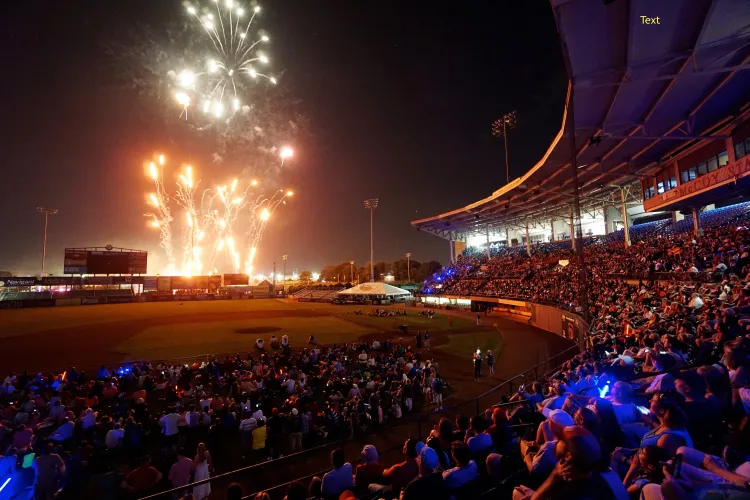






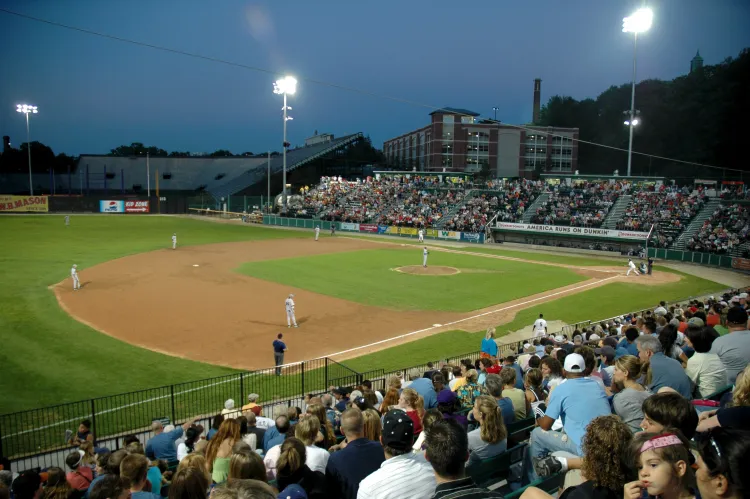


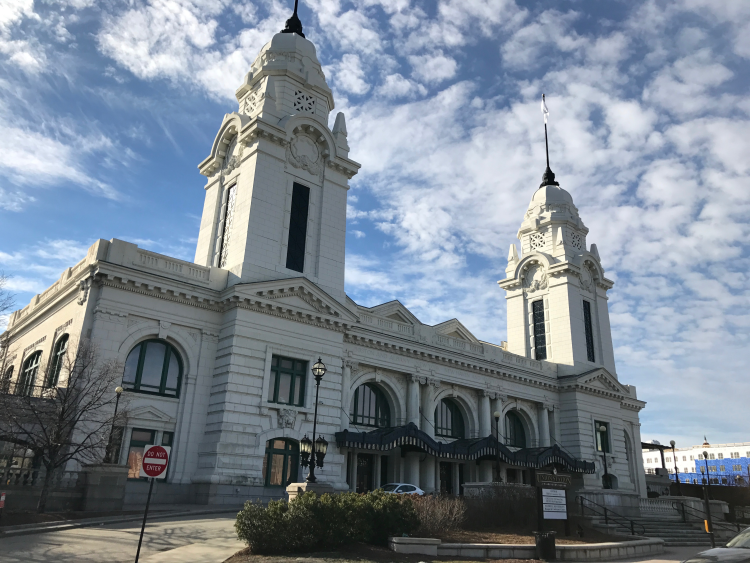
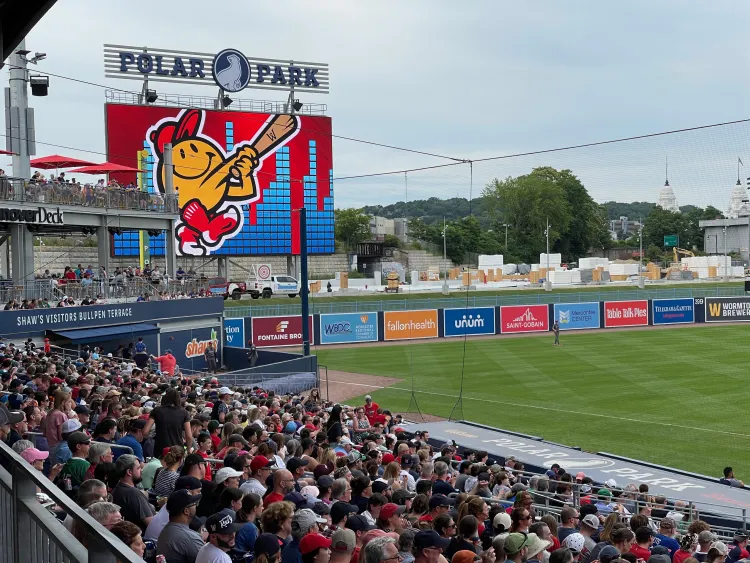

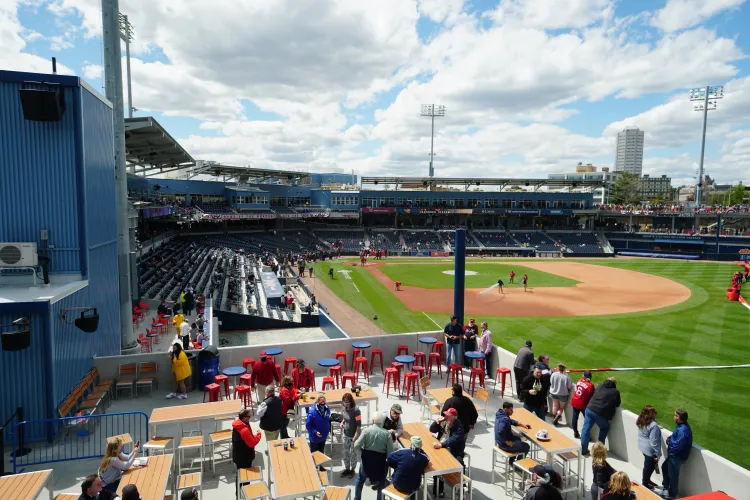

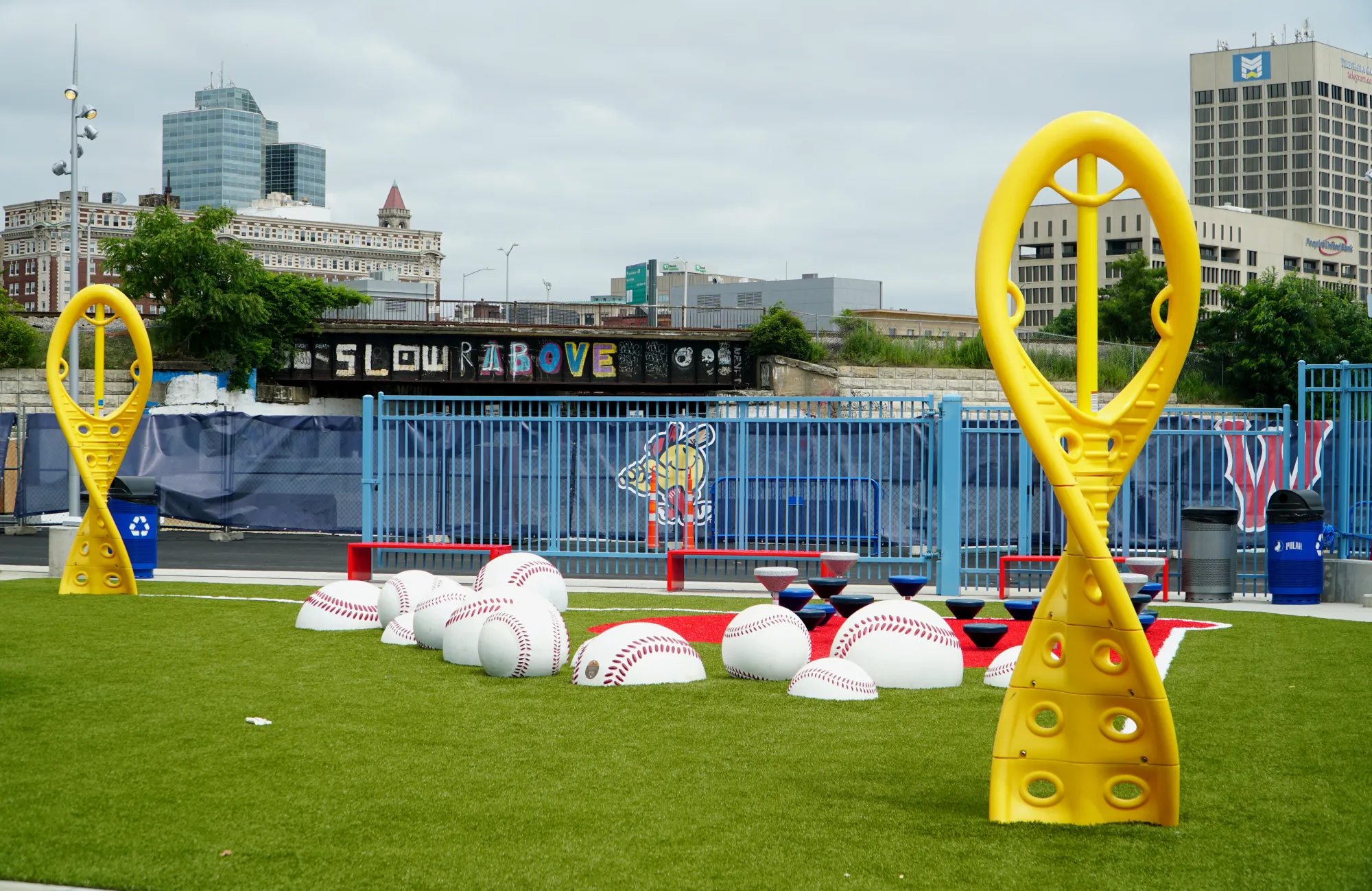

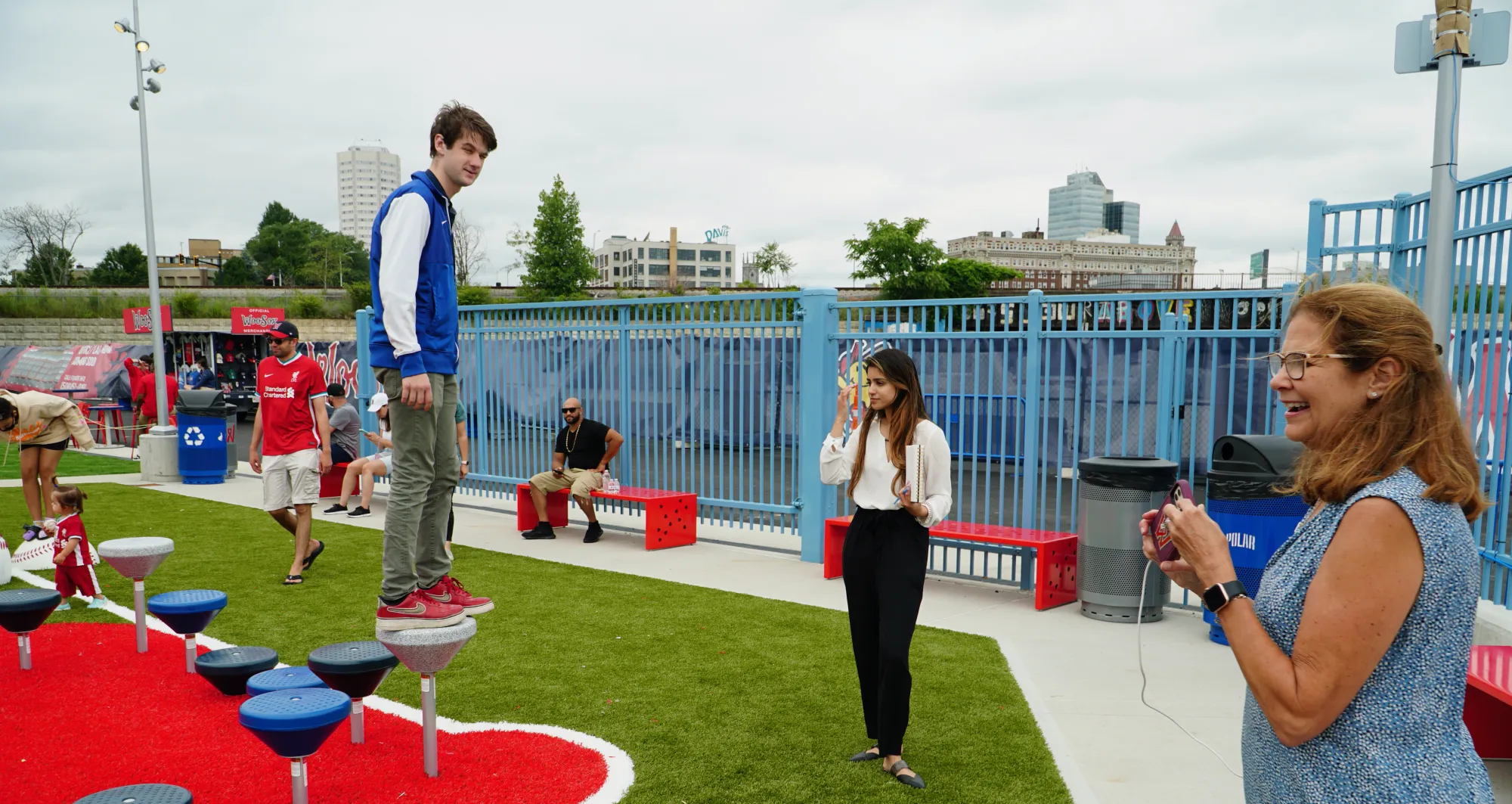

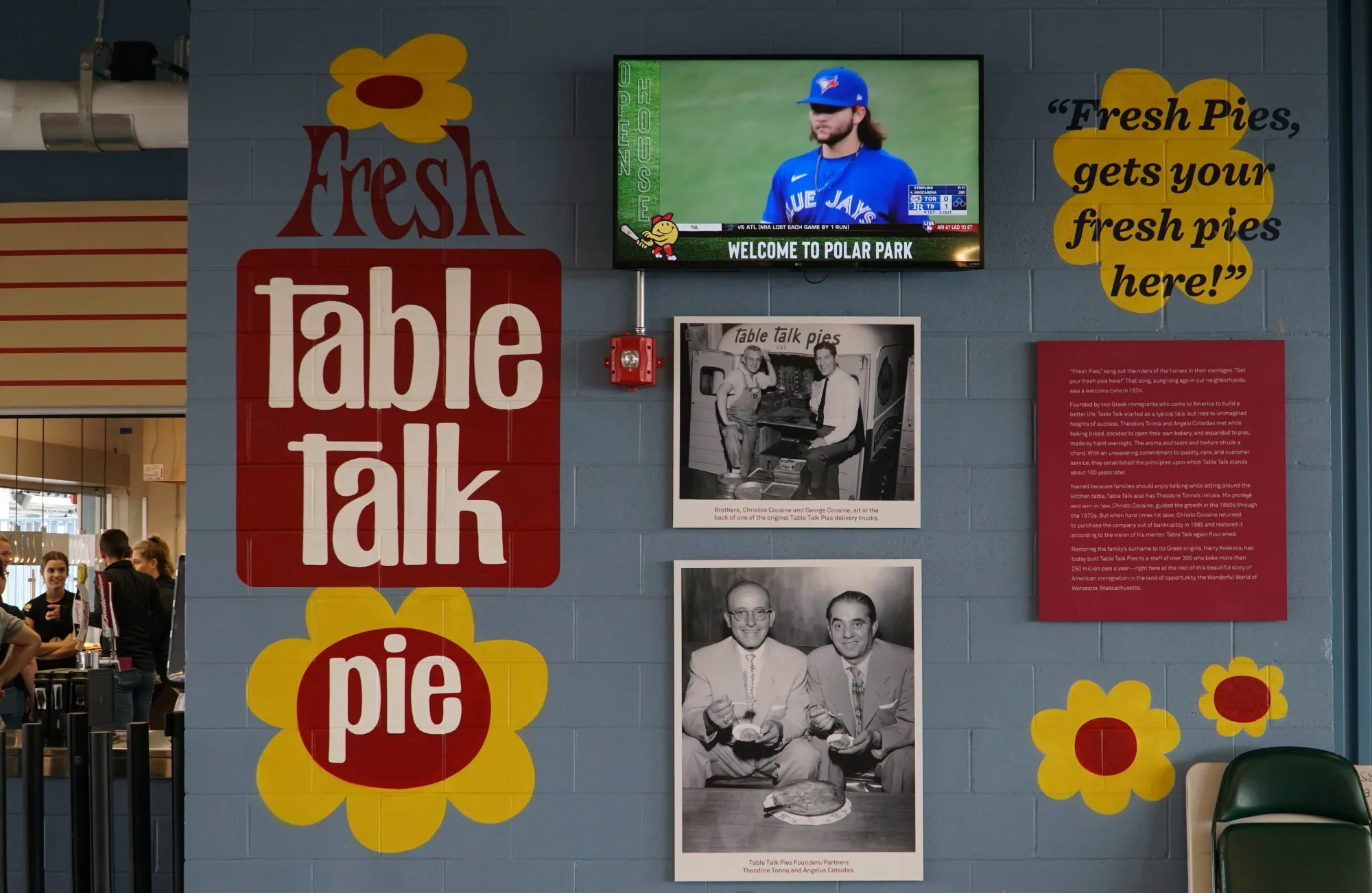







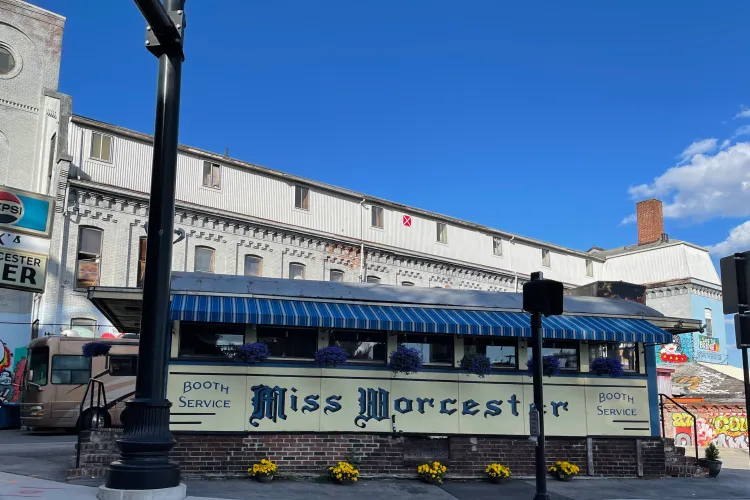













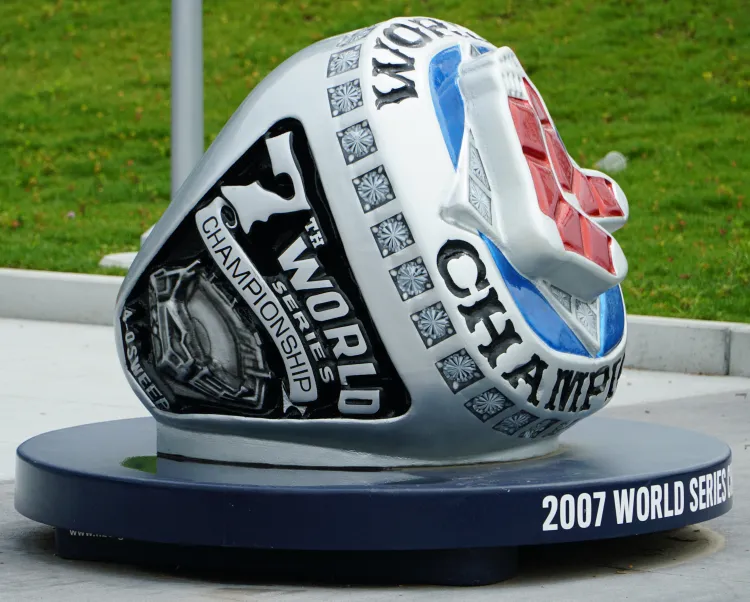

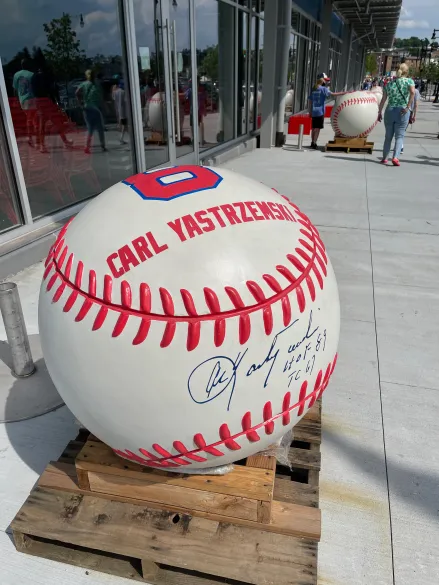









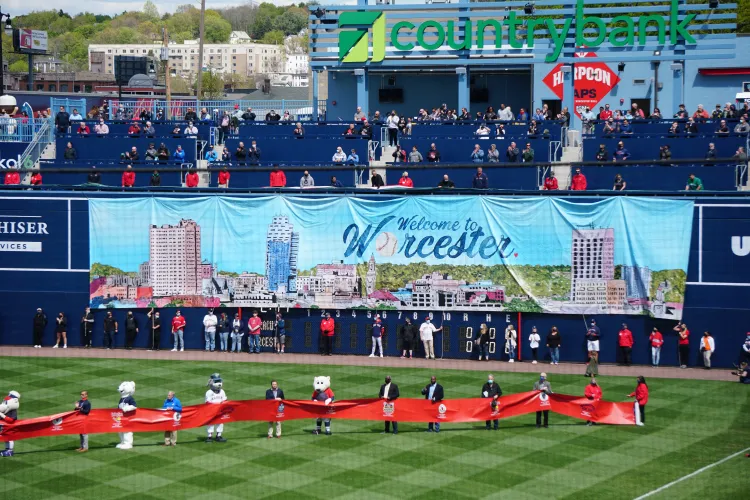



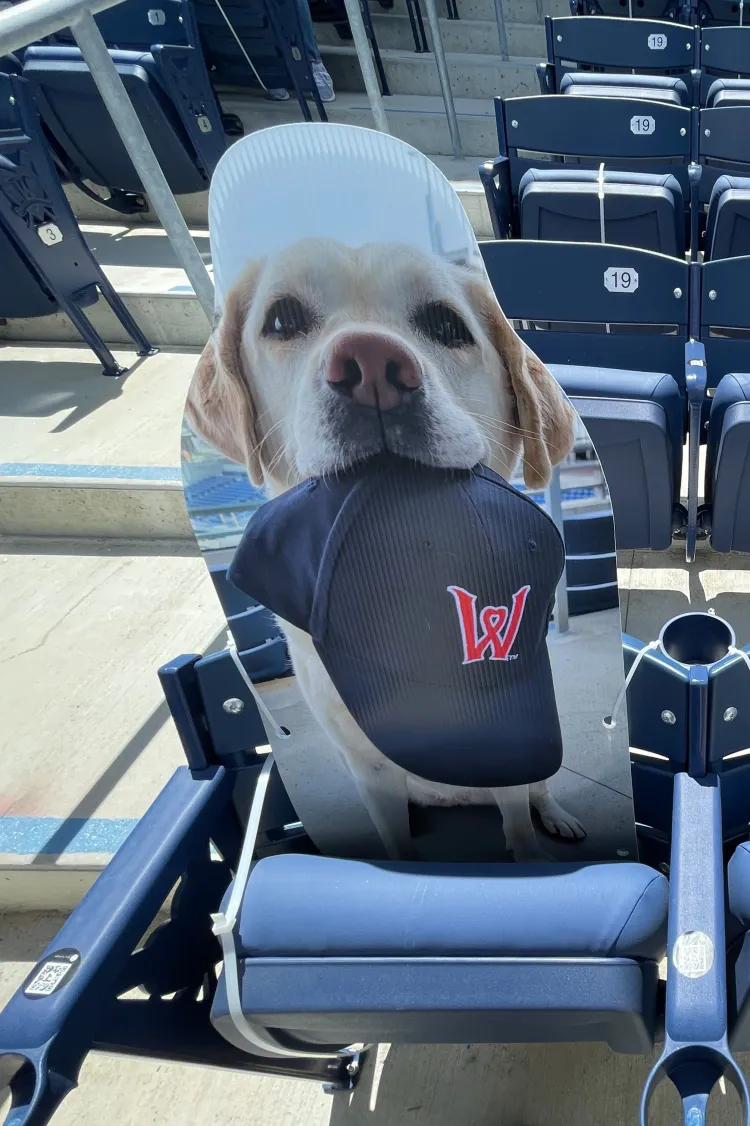


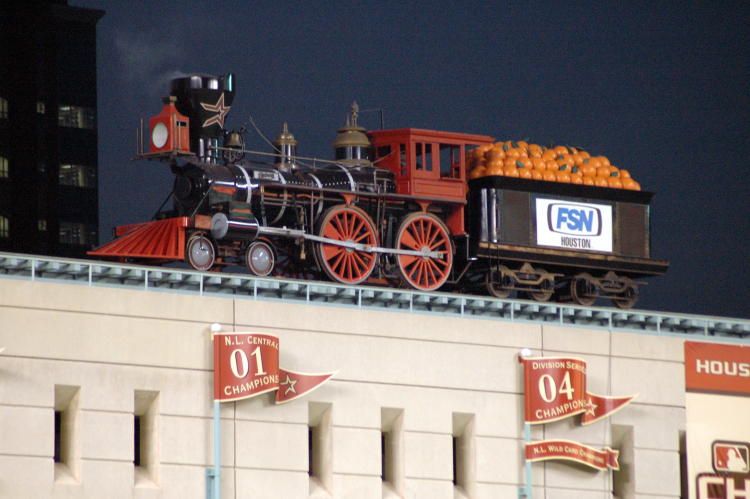

Comments